Leadership in Changing Organizations: M&S and House of Fraser Report
VerifiedAdded on 2022/12/15
|23
|6884
|333
Report
AI Summary
This report examines the impact of internal and external drivers of change on leadership, team dynamics, and individual behaviors within organizations. It evaluates the responses of Marks & Spencer and House of Fraser to change, utilizing the Burke-Litwin 12-model of organizational change to analyze factors like external environment, structure, leadership, management practices, mission, strategy, systems, organizational culture, work unit climate, tasks and skills, individual values and needs, motivation level, and individual and overall performance. The report further applies leadership approaches, including situational leadership, Kurt Lewin’s change model, and John Kotter’s 8-step model, to assess their effectiveness in meeting organizational objectives. The analysis includes a discussion of current issues faced by both companies and concludes with an evaluation of the models used.
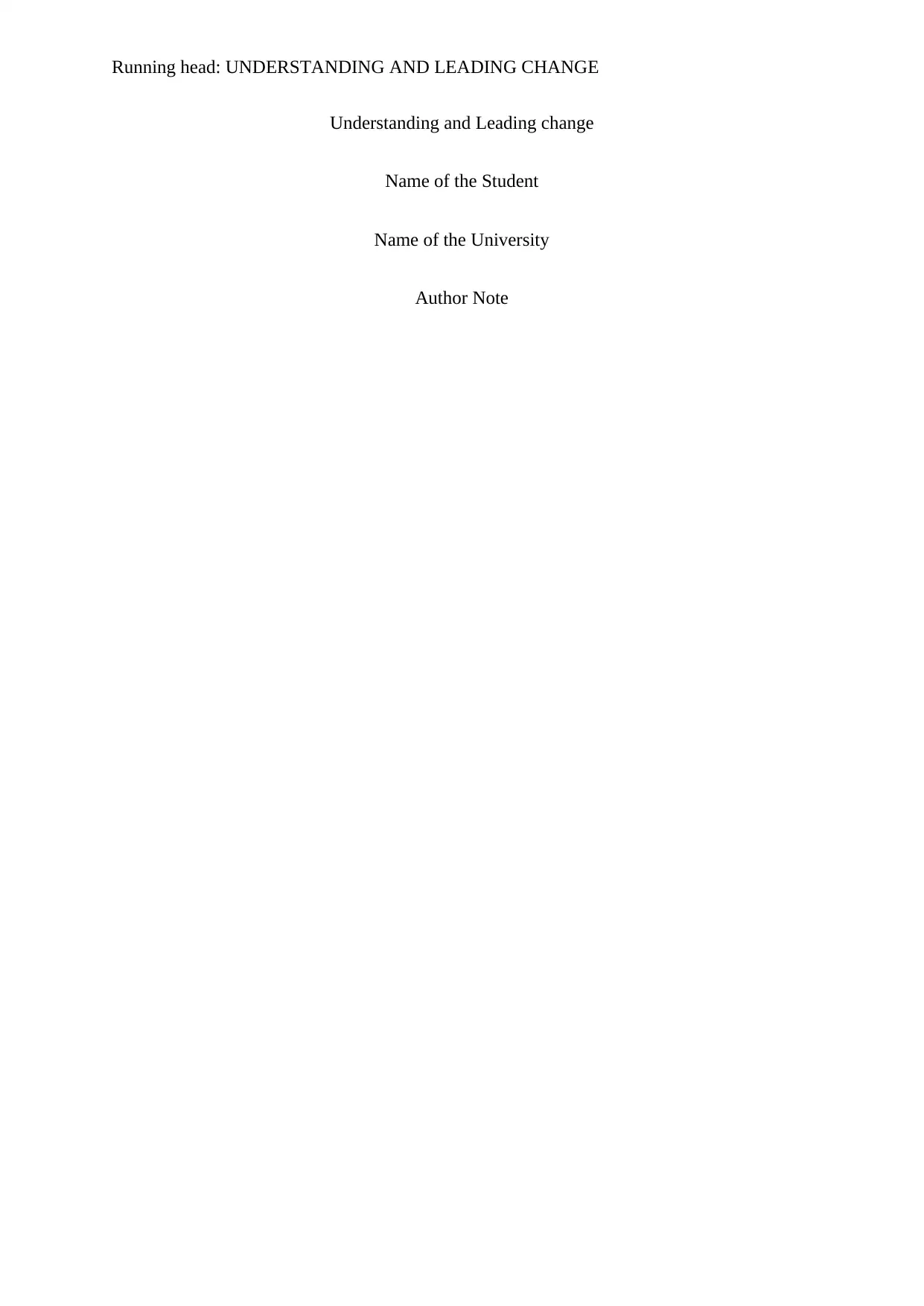
Running head: UNDERSTANDING AND LEADING CHANGE
Understanding and Leading change
Name of the Student
Name of the University
Author Note
Understanding and Leading change
Name of the Student
Name of the University
Author Note
Paraphrase This Document
Need a fresh take? Get an instant paraphrase of this document with our AI Paraphraser
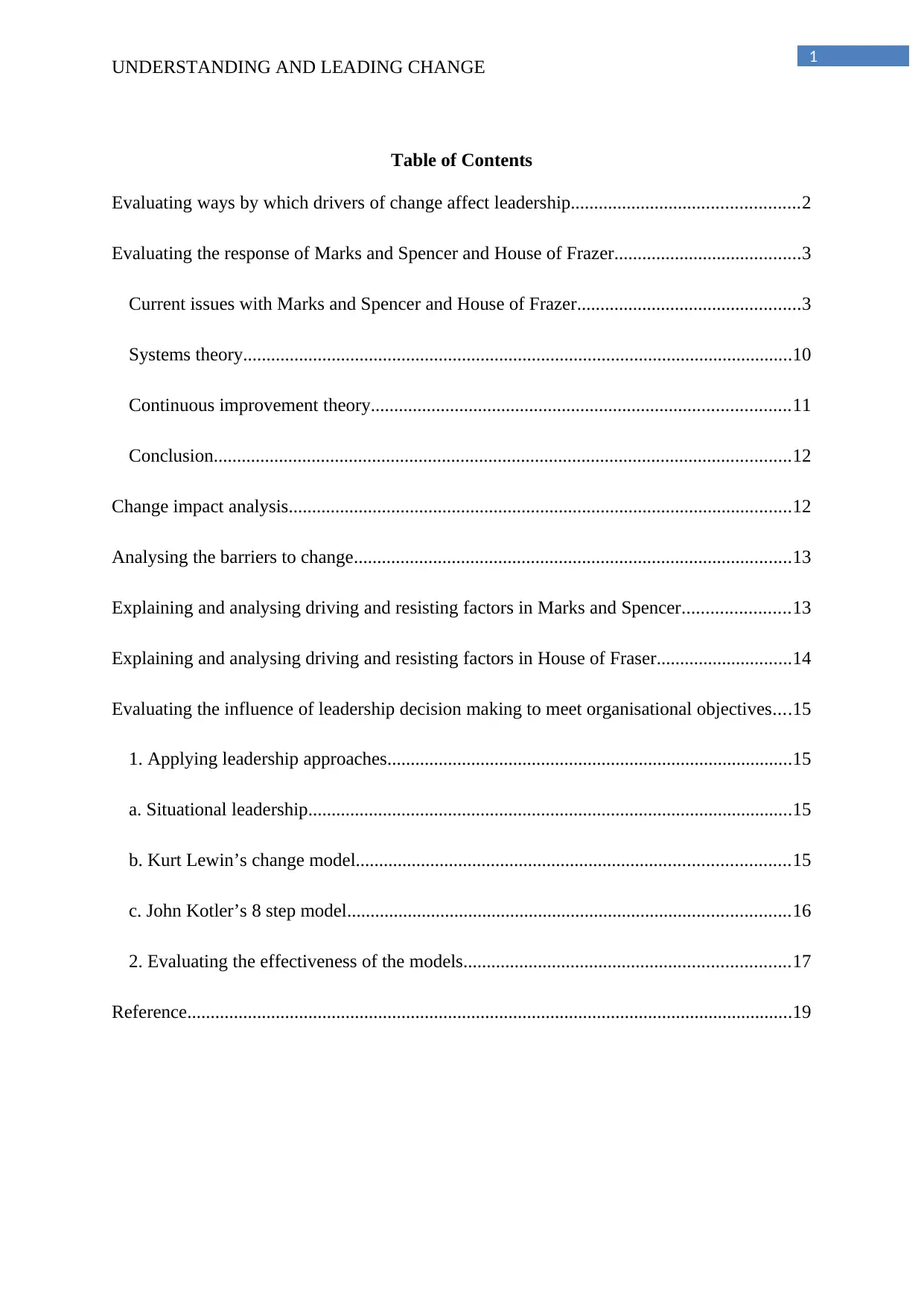
1
UNDERSTANDING AND LEADING CHANGE
Table of Contents
Evaluating ways by which drivers of change affect leadership.................................................2
Evaluating the response of Marks and Spencer and House of Frazer........................................3
Current issues with Marks and Spencer and House of Frazer................................................3
Systems theory......................................................................................................................10
Continuous improvement theory..........................................................................................11
Conclusion............................................................................................................................12
Change impact analysis............................................................................................................12
Analysing the barriers to change..............................................................................................13
Explaining and analysing driving and resisting factors in Marks and Spencer.......................13
Explaining and analysing driving and resisting factors in House of Fraser.............................14
Evaluating the influence of leadership decision making to meet organisational objectives....15
1. Applying leadership approaches.......................................................................................15
a. Situational leadership........................................................................................................15
b. Kurt Lewin’s change model.............................................................................................15
c. John Kotler’s 8 step model...............................................................................................16
2. Evaluating the effectiveness of the models......................................................................17
Reference..................................................................................................................................19
UNDERSTANDING AND LEADING CHANGE
Table of Contents
Evaluating ways by which drivers of change affect leadership.................................................2
Evaluating the response of Marks and Spencer and House of Frazer........................................3
Current issues with Marks and Spencer and House of Frazer................................................3
Systems theory......................................................................................................................10
Continuous improvement theory..........................................................................................11
Conclusion............................................................................................................................12
Change impact analysis............................................................................................................12
Analysing the barriers to change..............................................................................................13
Explaining and analysing driving and resisting factors in Marks and Spencer.......................13
Explaining and analysing driving and resisting factors in House of Fraser.............................14
Evaluating the influence of leadership decision making to meet organisational objectives....15
1. Applying leadership approaches.......................................................................................15
a. Situational leadership........................................................................................................15
b. Kurt Lewin’s change model.............................................................................................15
c. John Kotler’s 8 step model...............................................................................................16
2. Evaluating the effectiveness of the models......................................................................17
Reference..................................................................................................................................19
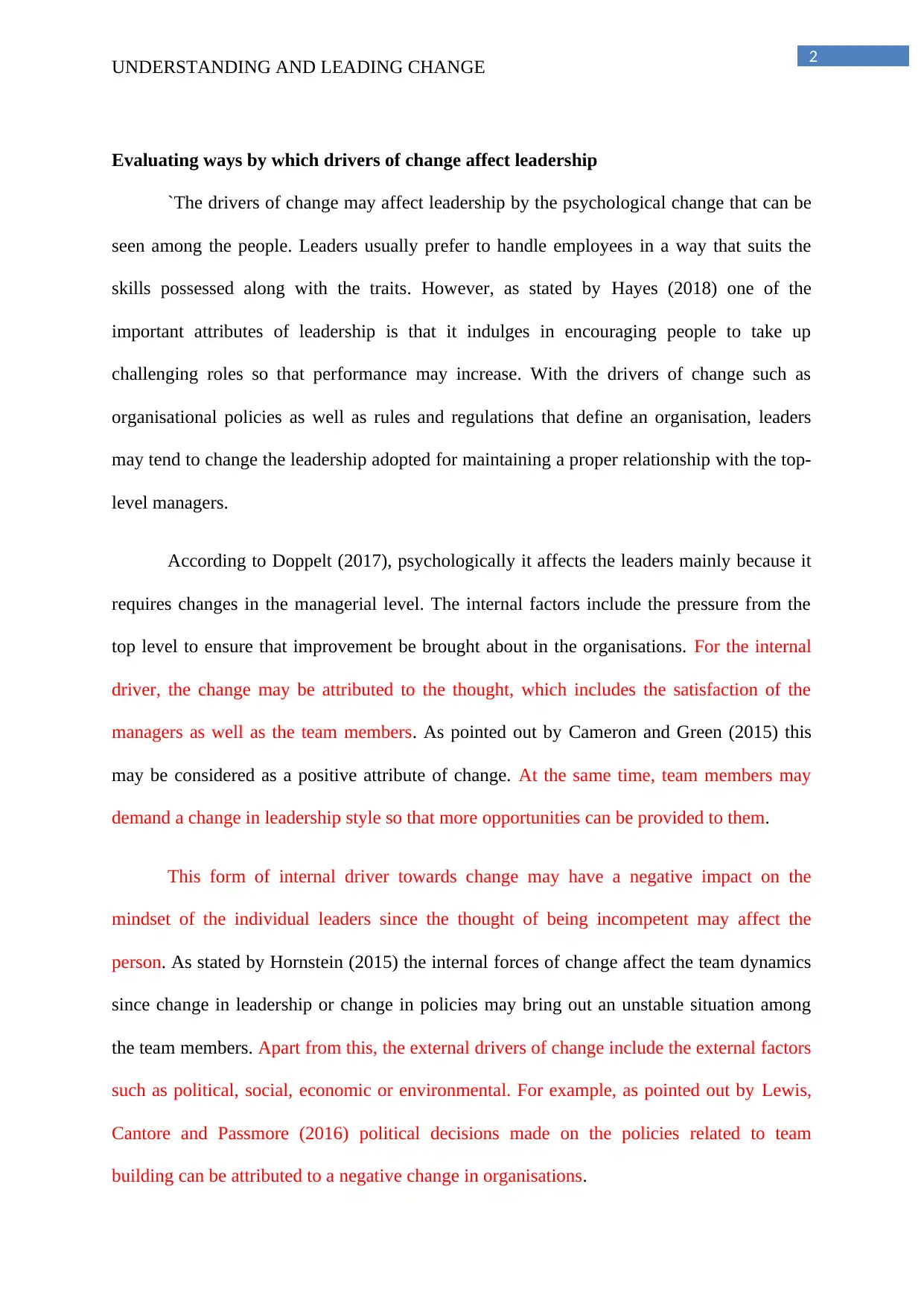
2
UNDERSTANDING AND LEADING CHANGE
Evaluating ways by which drivers of change affect leadership
`The drivers of change may affect leadership by the psychological change that can be
seen among the people. Leaders usually prefer to handle employees in a way that suits the
skills possessed along with the traits. However, as stated by Hayes (2018) one of the
important attributes of leadership is that it indulges in encouraging people to take up
challenging roles so that performance may increase. With the drivers of change such as
organisational policies as well as rules and regulations that define an organisation, leaders
may tend to change the leadership adopted for maintaining a proper relationship with the top-
level managers.
According to Doppelt (2017), psychologically it affects the leaders mainly because it
requires changes in the managerial level. The internal factors include the pressure from the
top level to ensure that improvement be brought about in the organisations. For the internal
driver, the change may be attributed to the thought, which includes the satisfaction of the
managers as well as the team members. As pointed out by Cameron and Green (2015) this
may be considered as a positive attribute of change. At the same time, team members may
demand a change in leadership style so that more opportunities can be provided to them.
This form of internal driver towards change may have a negative impact on the
mindset of the individual leaders since the thought of being incompetent may affect the
person. As stated by Hornstein (2015) the internal forces of change affect the team dynamics
since change in leadership or change in policies may bring out an unstable situation among
the team members. Apart from this, the external drivers of change include the external factors
such as political, social, economic or environmental. For example, as pointed out by Lewis,
Cantore and Passmore (2016) political decisions made on the policies related to team
building can be attributed to a negative change in organisations.
UNDERSTANDING AND LEADING CHANGE
Evaluating ways by which drivers of change affect leadership
`The drivers of change may affect leadership by the psychological change that can be
seen among the people. Leaders usually prefer to handle employees in a way that suits the
skills possessed along with the traits. However, as stated by Hayes (2018) one of the
important attributes of leadership is that it indulges in encouraging people to take up
challenging roles so that performance may increase. With the drivers of change such as
organisational policies as well as rules and regulations that define an organisation, leaders
may tend to change the leadership adopted for maintaining a proper relationship with the top-
level managers.
According to Doppelt (2017), psychologically it affects the leaders mainly because it
requires changes in the managerial level. The internal factors include the pressure from the
top level to ensure that improvement be brought about in the organisations. For the internal
driver, the change may be attributed to the thought, which includes the satisfaction of the
managers as well as the team members. As pointed out by Cameron and Green (2015) this
may be considered as a positive attribute of change. At the same time, team members may
demand a change in leadership style so that more opportunities can be provided to them.
This form of internal driver towards change may have a negative impact on the
mindset of the individual leaders since the thought of being incompetent may affect the
person. As stated by Hornstein (2015) the internal forces of change affect the team dynamics
since change in leadership or change in policies may bring out an unstable situation among
the team members. Apart from this, the external drivers of change include the external factors
such as political, social, economic or environmental. For example, as pointed out by Lewis,
Cantore and Passmore (2016) political decisions made on the policies related to team
building can be attributed to a negative change in organisations.
⊘ This is a preview!⊘
Do you want full access?
Subscribe today to unlock all pages.

Trusted by 1+ million students worldwide
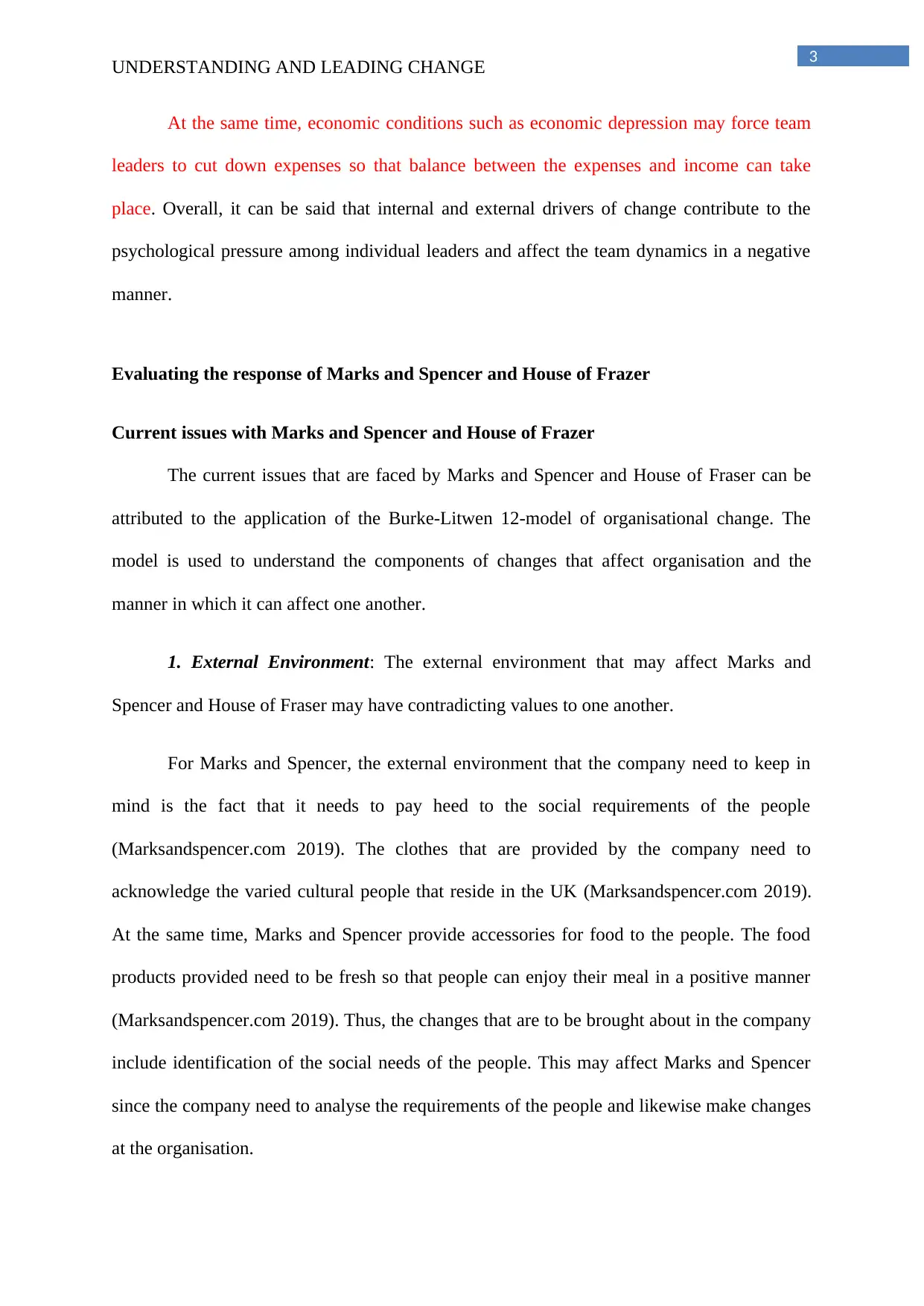
3
UNDERSTANDING AND LEADING CHANGE
At the same time, economic conditions such as economic depression may force team
leaders to cut down expenses so that balance between the expenses and income can take
place. Overall, it can be said that internal and external drivers of change contribute to the
psychological pressure among individual leaders and affect the team dynamics in a negative
manner.
Evaluating the response of Marks and Spencer and House of Frazer
Current issues with Marks and Spencer and House of Frazer
The current issues that are faced by Marks and Spencer and House of Fraser can be
attributed to the application of the Burke-Litwen 12-model of organisational change. The
model is used to understand the components of changes that affect organisation and the
manner in which it can affect one another.
1. External Environment: The external environment that may affect Marks and
Spencer and House of Fraser may have contradicting values to one another.
For Marks and Spencer, the external environment that the company need to keep in
mind is the fact that it needs to pay heed to the social requirements of the people
(Marksandspencer.com 2019). The clothes that are provided by the company need to
acknowledge the varied cultural people that reside in the UK (Marksandspencer.com 2019).
At the same time, Marks and Spencer provide accessories for food to the people. The food
products provided need to be fresh so that people can enjoy their meal in a positive manner
(Marksandspencer.com 2019). Thus, the changes that are to be brought about in the company
include identification of the social needs of the people. This may affect Marks and Spencer
since the company need to analyse the requirements of the people and likewise make changes
at the organisation.
UNDERSTANDING AND LEADING CHANGE
At the same time, economic conditions such as economic depression may force team
leaders to cut down expenses so that balance between the expenses and income can take
place. Overall, it can be said that internal and external drivers of change contribute to the
psychological pressure among individual leaders and affect the team dynamics in a negative
manner.
Evaluating the response of Marks and Spencer and House of Frazer
Current issues with Marks and Spencer and House of Frazer
The current issues that are faced by Marks and Spencer and House of Fraser can be
attributed to the application of the Burke-Litwen 12-model of organisational change. The
model is used to understand the components of changes that affect organisation and the
manner in which it can affect one another.
1. External Environment: The external environment that may affect Marks and
Spencer and House of Fraser may have contradicting values to one another.
For Marks and Spencer, the external environment that the company need to keep in
mind is the fact that it needs to pay heed to the social requirements of the people
(Marksandspencer.com 2019). The clothes that are provided by the company need to
acknowledge the varied cultural people that reside in the UK (Marksandspencer.com 2019).
At the same time, Marks and Spencer provide accessories for food to the people. The food
products provided need to be fresh so that people can enjoy their meal in a positive manner
(Marksandspencer.com 2019). Thus, the changes that are to be brought about in the company
include identification of the social needs of the people. This may affect Marks and Spencer
since the company need to analyse the requirements of the people and likewise make changes
at the organisation.
Paraphrase This Document
Need a fresh take? Get an instant paraphrase of this document with our AI Paraphraser
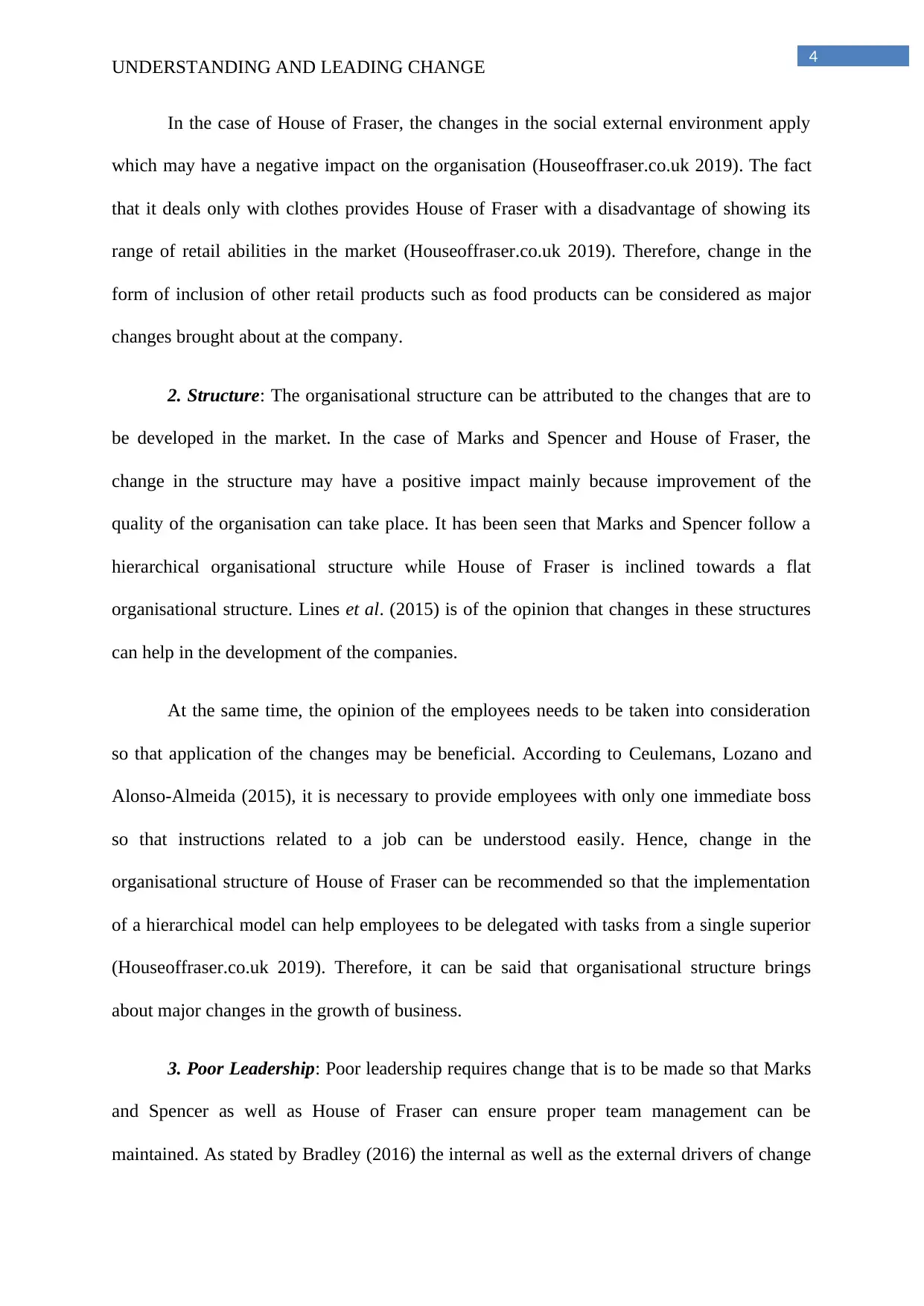
4
UNDERSTANDING AND LEADING CHANGE
In the case of House of Fraser, the changes in the social external environment apply
which may have a negative impact on the organisation (Houseoffraser.co.uk 2019). The fact
that it deals only with clothes provides House of Fraser with a disadvantage of showing its
range of retail abilities in the market (Houseoffraser.co.uk 2019). Therefore, change in the
form of inclusion of other retail products such as food products can be considered as major
changes brought about at the company.
2. Structure: The organisational structure can be attributed to the changes that are to
be developed in the market. In the case of Marks and Spencer and House of Fraser, the
change in the structure may have a positive impact mainly because improvement of the
quality of the organisation can take place. It has been seen that Marks and Spencer follow a
hierarchical organisational structure while House of Fraser is inclined towards a flat
organisational structure. Lines et al. (2015) is of the opinion that changes in these structures
can help in the development of the companies.
At the same time, the opinion of the employees needs to be taken into consideration
so that application of the changes may be beneficial. According to Ceulemans, Lozano and
Alonso-Almeida (2015), it is necessary to provide employees with only one immediate boss
so that instructions related to a job can be understood easily. Hence, change in the
organisational structure of House of Fraser can be recommended so that the implementation
of a hierarchical model can help employees to be delegated with tasks from a single superior
(Houseoffraser.co.uk 2019). Therefore, it can be said that organisational structure brings
about major changes in the growth of business.
3. Poor Leadership: Poor leadership requires change that is to be made so that Marks
and Spencer as well as House of Fraser can ensure proper team management can be
maintained. As stated by Bradley (2016) the internal as well as the external drivers of change
UNDERSTANDING AND LEADING CHANGE
In the case of House of Fraser, the changes in the social external environment apply
which may have a negative impact on the organisation (Houseoffraser.co.uk 2019). The fact
that it deals only with clothes provides House of Fraser with a disadvantage of showing its
range of retail abilities in the market (Houseoffraser.co.uk 2019). Therefore, change in the
form of inclusion of other retail products such as food products can be considered as major
changes brought about at the company.
2. Structure: The organisational structure can be attributed to the changes that are to
be developed in the market. In the case of Marks and Spencer and House of Fraser, the
change in the structure may have a positive impact mainly because improvement of the
quality of the organisation can take place. It has been seen that Marks and Spencer follow a
hierarchical organisational structure while House of Fraser is inclined towards a flat
organisational structure. Lines et al. (2015) is of the opinion that changes in these structures
can help in the development of the companies.
At the same time, the opinion of the employees needs to be taken into consideration
so that application of the changes may be beneficial. According to Ceulemans, Lozano and
Alonso-Almeida (2015), it is necessary to provide employees with only one immediate boss
so that instructions related to a job can be understood easily. Hence, change in the
organisational structure of House of Fraser can be recommended so that the implementation
of a hierarchical model can help employees to be delegated with tasks from a single superior
(Houseoffraser.co.uk 2019). Therefore, it can be said that organisational structure brings
about major changes in the growth of business.
3. Poor Leadership: Poor leadership requires change that is to be made so that Marks
and Spencer as well as House of Fraser can ensure proper team management can be
maintained. As stated by Bradley (2016) the internal as well as the external drivers of change
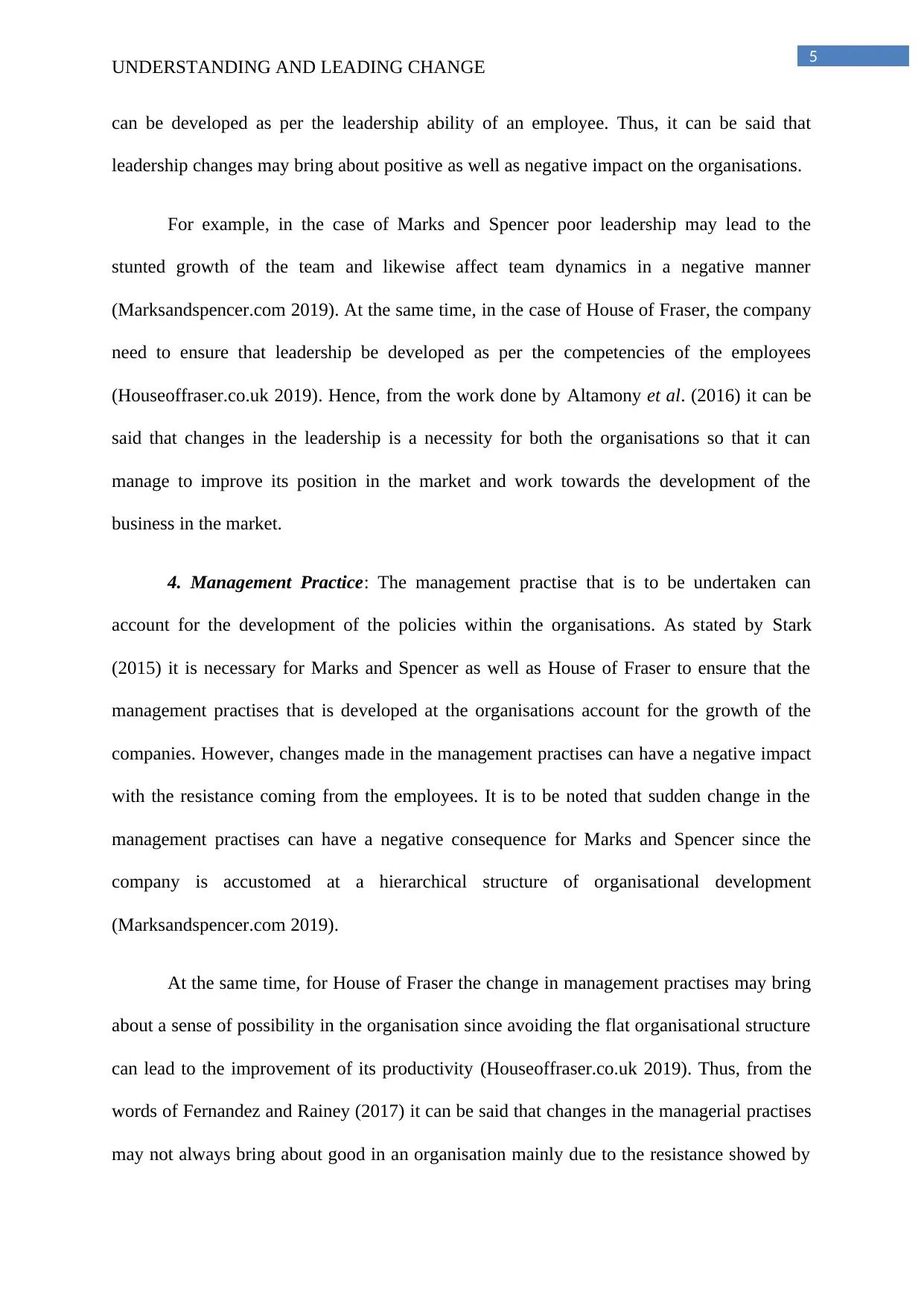
5
UNDERSTANDING AND LEADING CHANGE
can be developed as per the leadership ability of an employee. Thus, it can be said that
leadership changes may bring about positive as well as negative impact on the organisations.
For example, in the case of Marks and Spencer poor leadership may lead to the
stunted growth of the team and likewise affect team dynamics in a negative manner
(Marksandspencer.com 2019). At the same time, in the case of House of Fraser, the company
need to ensure that leadership be developed as per the competencies of the employees
(Houseoffraser.co.uk 2019). Hence, from the work done by Altamony et al. (2016) it can be
said that changes in the leadership is a necessity for both the organisations so that it can
manage to improve its position in the market and work towards the development of the
business in the market.
4. Management Practice: The management practise that is to be undertaken can
account for the development of the policies within the organisations. As stated by Stark
(2015) it is necessary for Marks and Spencer as well as House of Fraser to ensure that the
management practises that is developed at the organisations account for the growth of the
companies. However, changes made in the management practises can have a negative impact
with the resistance coming from the employees. It is to be noted that sudden change in the
management practises can have a negative consequence for Marks and Spencer since the
company is accustomed at a hierarchical structure of organisational development
(Marksandspencer.com 2019).
At the same time, for House of Fraser the change in management practises may bring
about a sense of possibility in the organisation since avoiding the flat organisational structure
can lead to the improvement of its productivity (Houseoffraser.co.uk 2019). Thus, from the
words of Fernandez and Rainey (2017) it can be said that changes in the managerial practises
may not always bring about good in an organisation mainly due to the resistance showed by
UNDERSTANDING AND LEADING CHANGE
can be developed as per the leadership ability of an employee. Thus, it can be said that
leadership changes may bring about positive as well as negative impact on the organisations.
For example, in the case of Marks and Spencer poor leadership may lead to the
stunted growth of the team and likewise affect team dynamics in a negative manner
(Marksandspencer.com 2019). At the same time, in the case of House of Fraser, the company
need to ensure that leadership be developed as per the competencies of the employees
(Houseoffraser.co.uk 2019). Hence, from the work done by Altamony et al. (2016) it can be
said that changes in the leadership is a necessity for both the organisations so that it can
manage to improve its position in the market and work towards the development of the
business in the market.
4. Management Practice: The management practise that is to be undertaken can
account for the development of the policies within the organisations. As stated by Stark
(2015) it is necessary for Marks and Spencer as well as House of Fraser to ensure that the
management practises that is developed at the organisations account for the growth of the
companies. However, changes made in the management practises can have a negative impact
with the resistance coming from the employees. It is to be noted that sudden change in the
management practises can have a negative consequence for Marks and Spencer since the
company is accustomed at a hierarchical structure of organisational development
(Marksandspencer.com 2019).
At the same time, for House of Fraser the change in management practises may bring
about a sense of possibility in the organisation since avoiding the flat organisational structure
can lead to the improvement of its productivity (Houseoffraser.co.uk 2019). Thus, from the
words of Fernandez and Rainey (2017) it can be said that changes in the managerial practises
may not always bring about good in an organisation mainly due to the resistance showed by
⊘ This is a preview!⊘
Do you want full access?
Subscribe today to unlock all pages.

Trusted by 1+ million students worldwide
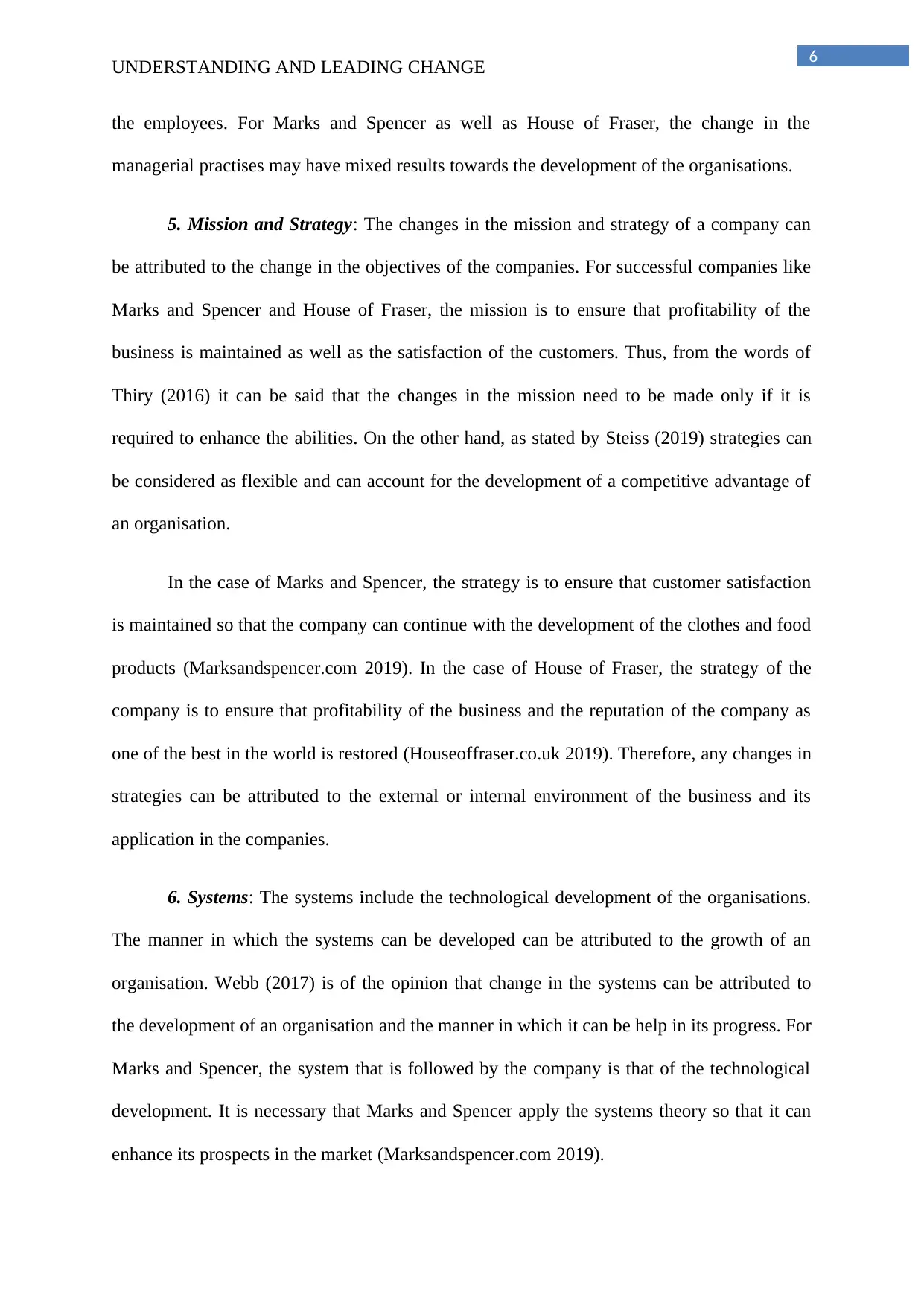
6
UNDERSTANDING AND LEADING CHANGE
the employees. For Marks and Spencer as well as House of Fraser, the change in the
managerial practises may have mixed results towards the development of the organisations.
5. Mission and Strategy: The changes in the mission and strategy of a company can
be attributed to the change in the objectives of the companies. For successful companies like
Marks and Spencer and House of Fraser, the mission is to ensure that profitability of the
business is maintained as well as the satisfaction of the customers. Thus, from the words of
Thiry (2016) it can be said that the changes in the mission need to be made only if it is
required to enhance the abilities. On the other hand, as stated by Steiss (2019) strategies can
be considered as flexible and can account for the development of a competitive advantage of
an organisation.
In the case of Marks and Spencer, the strategy is to ensure that customer satisfaction
is maintained so that the company can continue with the development of the clothes and food
products (Marksandspencer.com 2019). In the case of House of Fraser, the strategy of the
company is to ensure that profitability of the business and the reputation of the company as
one of the best in the world is restored (Houseoffraser.co.uk 2019). Therefore, any changes in
strategies can be attributed to the external or internal environment of the business and its
application in the companies.
6. Systems: The systems include the technological development of the organisations.
The manner in which the systems can be developed can be attributed to the growth of an
organisation. Webb (2017) is of the opinion that change in the systems can be attributed to
the development of an organisation and the manner in which it can be help in its progress. For
Marks and Spencer, the system that is followed by the company is that of the technological
development. It is necessary that Marks and Spencer apply the systems theory so that it can
enhance its prospects in the market (Marksandspencer.com 2019).
UNDERSTANDING AND LEADING CHANGE
the employees. For Marks and Spencer as well as House of Fraser, the change in the
managerial practises may have mixed results towards the development of the organisations.
5. Mission and Strategy: The changes in the mission and strategy of a company can
be attributed to the change in the objectives of the companies. For successful companies like
Marks and Spencer and House of Fraser, the mission is to ensure that profitability of the
business is maintained as well as the satisfaction of the customers. Thus, from the words of
Thiry (2016) it can be said that the changes in the mission need to be made only if it is
required to enhance the abilities. On the other hand, as stated by Steiss (2019) strategies can
be considered as flexible and can account for the development of a competitive advantage of
an organisation.
In the case of Marks and Spencer, the strategy is to ensure that customer satisfaction
is maintained so that the company can continue with the development of the clothes and food
products (Marksandspencer.com 2019). In the case of House of Fraser, the strategy of the
company is to ensure that profitability of the business and the reputation of the company as
one of the best in the world is restored (Houseoffraser.co.uk 2019). Therefore, any changes in
strategies can be attributed to the external or internal environment of the business and its
application in the companies.
6. Systems: The systems include the technological development of the organisations.
The manner in which the systems can be developed can be attributed to the growth of an
organisation. Webb (2017) is of the opinion that change in the systems can be attributed to
the development of an organisation and the manner in which it can be help in its progress. For
Marks and Spencer, the system that is followed by the company is that of the technological
development. It is necessary that Marks and Spencer apply the systems theory so that it can
enhance its prospects in the market (Marksandspencer.com 2019).
Paraphrase This Document
Need a fresh take? Get an instant paraphrase of this document with our AI Paraphraser
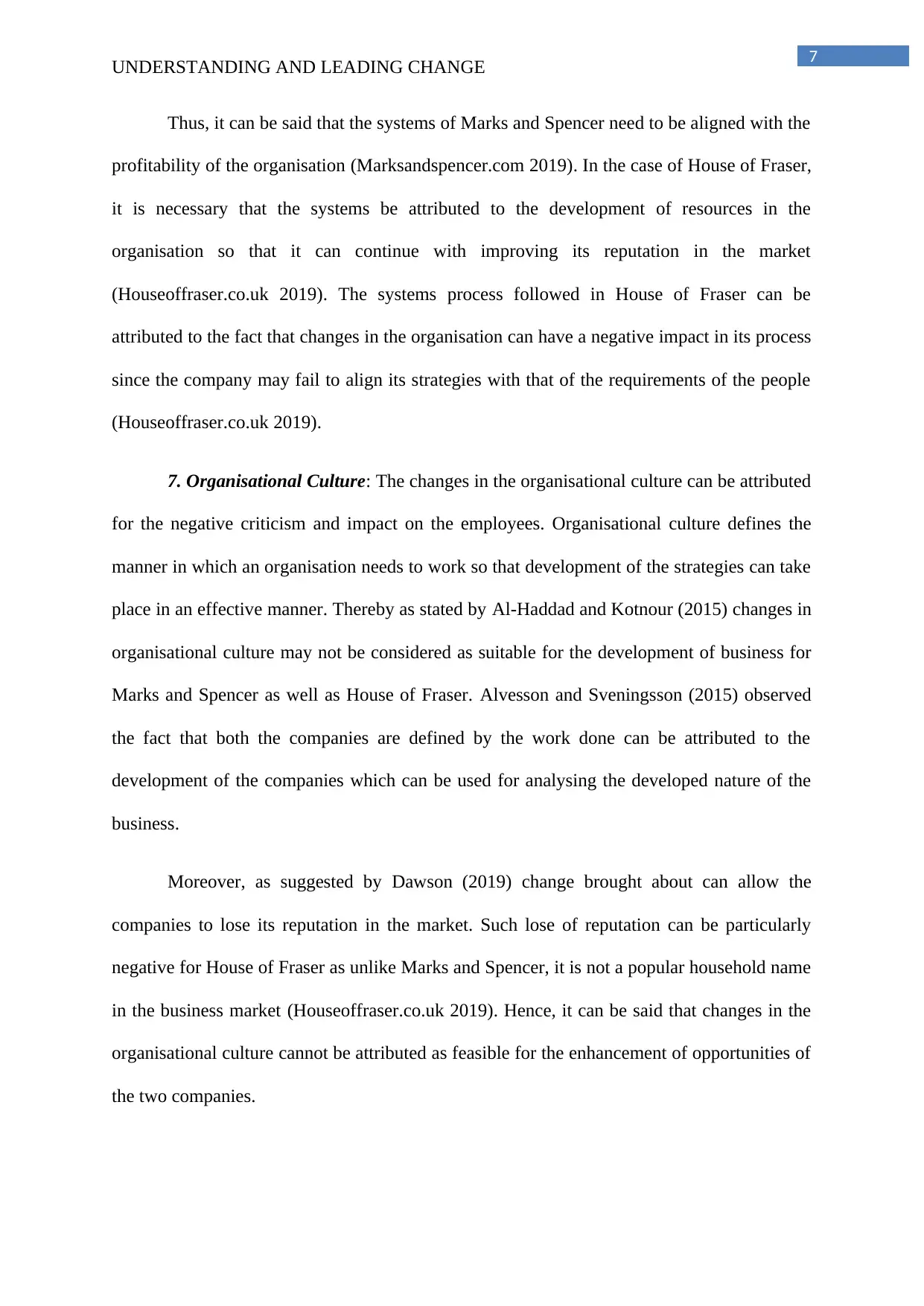
7
UNDERSTANDING AND LEADING CHANGE
Thus, it can be said that the systems of Marks and Spencer need to be aligned with the
profitability of the organisation (Marksandspencer.com 2019). In the case of House of Fraser,
it is necessary that the systems be attributed to the development of resources in the
organisation so that it can continue with improving its reputation in the market
(Houseoffraser.co.uk 2019). The systems process followed in House of Fraser can be
attributed to the fact that changes in the organisation can have a negative impact in its process
since the company may fail to align its strategies with that of the requirements of the people
(Houseoffraser.co.uk 2019).
7. Organisational Culture: The changes in the organisational culture can be attributed
for the negative criticism and impact on the employees. Organisational culture defines the
manner in which an organisation needs to work so that development of the strategies can take
place in an effective manner. Thereby as stated by Al-Haddad and Kotnour (2015) changes in
organisational culture may not be considered as suitable for the development of business for
Marks and Spencer as well as House of Fraser. Alvesson and Sveningsson (2015) observed
the fact that both the companies are defined by the work done can be attributed to the
development of the companies which can be used for analysing the developed nature of the
business.
Moreover, as suggested by Dawson (2019) change brought about can allow the
companies to lose its reputation in the market. Such lose of reputation can be particularly
negative for House of Fraser as unlike Marks and Spencer, it is not a popular household name
in the business market (Houseoffraser.co.uk 2019). Hence, it can be said that changes in the
organisational culture cannot be attributed as feasible for the enhancement of opportunities of
the two companies.
UNDERSTANDING AND LEADING CHANGE
Thus, it can be said that the systems of Marks and Spencer need to be aligned with the
profitability of the organisation (Marksandspencer.com 2019). In the case of House of Fraser,
it is necessary that the systems be attributed to the development of resources in the
organisation so that it can continue with improving its reputation in the market
(Houseoffraser.co.uk 2019). The systems process followed in House of Fraser can be
attributed to the fact that changes in the organisation can have a negative impact in its process
since the company may fail to align its strategies with that of the requirements of the people
(Houseoffraser.co.uk 2019).
7. Organisational Culture: The changes in the organisational culture can be attributed
for the negative criticism and impact on the employees. Organisational culture defines the
manner in which an organisation needs to work so that development of the strategies can take
place in an effective manner. Thereby as stated by Al-Haddad and Kotnour (2015) changes in
organisational culture may not be considered as suitable for the development of business for
Marks and Spencer as well as House of Fraser. Alvesson and Sveningsson (2015) observed
the fact that both the companies are defined by the work done can be attributed to the
development of the companies which can be used for analysing the developed nature of the
business.
Moreover, as suggested by Dawson (2019) change brought about can allow the
companies to lose its reputation in the market. Such lose of reputation can be particularly
negative for House of Fraser as unlike Marks and Spencer, it is not a popular household name
in the business market (Houseoffraser.co.uk 2019). Hence, it can be said that changes in the
organisational culture cannot be attributed as feasible for the enhancement of opportunities of
the two companies.
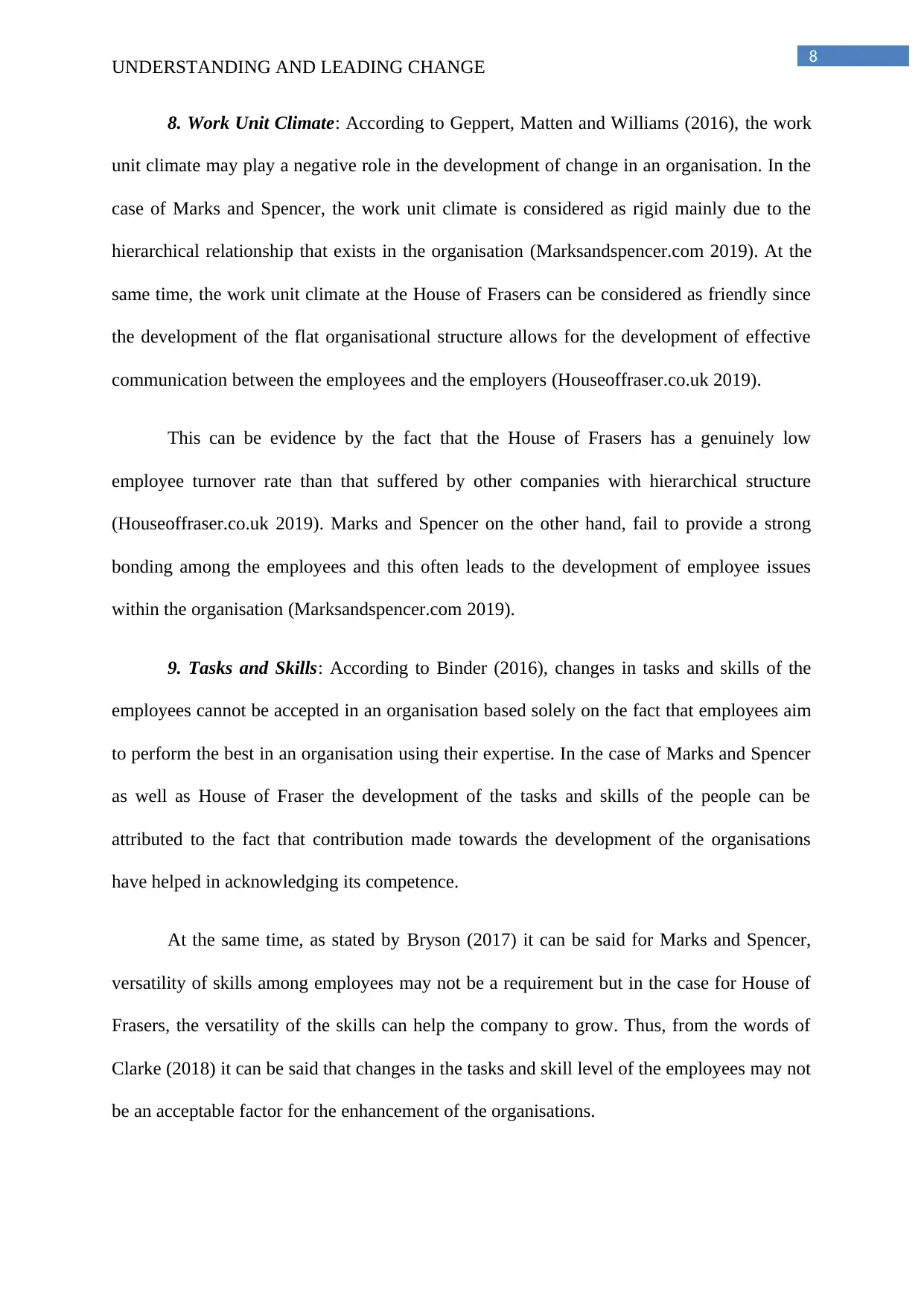
8
UNDERSTANDING AND LEADING CHANGE
8. Work Unit Climate: According to Geppert, Matten and Williams (2016), the work
unit climate may play a negative role in the development of change in an organisation. In the
case of Marks and Spencer, the work unit climate is considered as rigid mainly due to the
hierarchical relationship that exists in the organisation (Marksandspencer.com 2019). At the
same time, the work unit climate at the House of Frasers can be considered as friendly since
the development of the flat organisational structure allows for the development of effective
communication between the employees and the employers (Houseoffraser.co.uk 2019).
This can be evidence by the fact that the House of Frasers has a genuinely low
employee turnover rate than that suffered by other companies with hierarchical structure
(Houseoffraser.co.uk 2019). Marks and Spencer on the other hand, fail to provide a strong
bonding among the employees and this often leads to the development of employee issues
within the organisation (Marksandspencer.com 2019).
9. Tasks and Skills: According to Binder (2016), changes in tasks and skills of the
employees cannot be accepted in an organisation based solely on the fact that employees aim
to perform the best in an organisation using their expertise. In the case of Marks and Spencer
as well as House of Fraser the development of the tasks and skills of the people can be
attributed to the fact that contribution made towards the development of the organisations
have helped in acknowledging its competence.
At the same time, as stated by Bryson (2017) it can be said for Marks and Spencer,
versatility of skills among employees may not be a requirement but in the case for House of
Frasers, the versatility of the skills can help the company to grow. Thus, from the words of
Clarke (2018) it can be said that changes in the tasks and skill level of the employees may not
be an acceptable factor for the enhancement of the organisations.
UNDERSTANDING AND LEADING CHANGE
8. Work Unit Climate: According to Geppert, Matten and Williams (2016), the work
unit climate may play a negative role in the development of change in an organisation. In the
case of Marks and Spencer, the work unit climate is considered as rigid mainly due to the
hierarchical relationship that exists in the organisation (Marksandspencer.com 2019). At the
same time, the work unit climate at the House of Frasers can be considered as friendly since
the development of the flat organisational structure allows for the development of effective
communication between the employees and the employers (Houseoffraser.co.uk 2019).
This can be evidence by the fact that the House of Frasers has a genuinely low
employee turnover rate than that suffered by other companies with hierarchical structure
(Houseoffraser.co.uk 2019). Marks and Spencer on the other hand, fail to provide a strong
bonding among the employees and this often leads to the development of employee issues
within the organisation (Marksandspencer.com 2019).
9. Tasks and Skills: According to Binder (2016), changes in tasks and skills of the
employees cannot be accepted in an organisation based solely on the fact that employees aim
to perform the best in an organisation using their expertise. In the case of Marks and Spencer
as well as House of Fraser the development of the tasks and skills of the people can be
attributed to the fact that contribution made towards the development of the organisations
have helped in acknowledging its competence.
At the same time, as stated by Bryson (2017) it can be said for Marks and Spencer,
versatility of skills among employees may not be a requirement but in the case for House of
Frasers, the versatility of the skills can help the company to grow. Thus, from the words of
Clarke (2018) it can be said that changes in the tasks and skill level of the employees may not
be an acceptable factor for the enhancement of the organisations.
⊘ This is a preview!⊘
Do you want full access?
Subscribe today to unlock all pages.

Trusted by 1+ million students worldwide
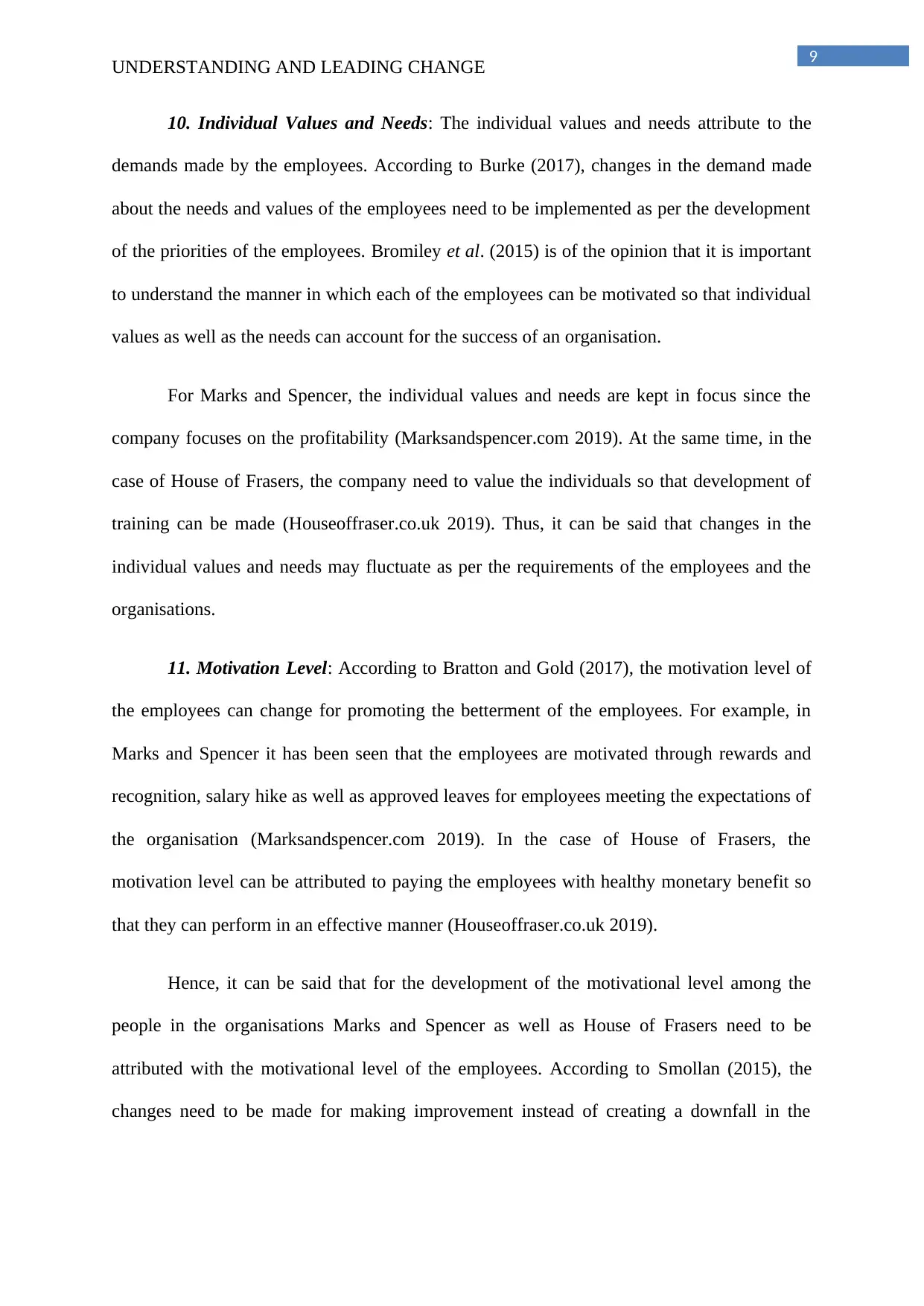
9
UNDERSTANDING AND LEADING CHANGE
10. Individual Values and Needs: The individual values and needs attribute to the
demands made by the employees. According to Burke (2017), changes in the demand made
about the needs and values of the employees need to be implemented as per the development
of the priorities of the employees. Bromiley et al. (2015) is of the opinion that it is important
to understand the manner in which each of the employees can be motivated so that individual
values as well as the needs can account for the success of an organisation.
For Marks and Spencer, the individual values and needs are kept in focus since the
company focuses on the profitability (Marksandspencer.com 2019). At the same time, in the
case of House of Frasers, the company need to value the individuals so that development of
training can be made (Houseoffraser.co.uk 2019). Thus, it can be said that changes in the
individual values and needs may fluctuate as per the requirements of the employees and the
organisations.
11. Motivation Level: According to Bratton and Gold (2017), the motivation level of
the employees can change for promoting the betterment of the employees. For example, in
Marks and Spencer it has been seen that the employees are motivated through rewards and
recognition, salary hike as well as approved leaves for employees meeting the expectations of
the organisation (Marksandspencer.com 2019). In the case of House of Frasers, the
motivation level can be attributed to paying the employees with healthy monetary benefit so
that they can perform in an effective manner (Houseoffraser.co.uk 2019).
Hence, it can be said that for the development of the motivational level among the
people in the organisations Marks and Spencer as well as House of Frasers need to be
attributed with the motivational level of the employees. According to Smollan (2015), the
changes need to be made for making improvement instead of creating a downfall in the
UNDERSTANDING AND LEADING CHANGE
10. Individual Values and Needs: The individual values and needs attribute to the
demands made by the employees. According to Burke (2017), changes in the demand made
about the needs and values of the employees need to be implemented as per the development
of the priorities of the employees. Bromiley et al. (2015) is of the opinion that it is important
to understand the manner in which each of the employees can be motivated so that individual
values as well as the needs can account for the success of an organisation.
For Marks and Spencer, the individual values and needs are kept in focus since the
company focuses on the profitability (Marksandspencer.com 2019). At the same time, in the
case of House of Frasers, the company need to value the individuals so that development of
training can be made (Houseoffraser.co.uk 2019). Thus, it can be said that changes in the
individual values and needs may fluctuate as per the requirements of the employees and the
organisations.
11. Motivation Level: According to Bratton and Gold (2017), the motivation level of
the employees can change for promoting the betterment of the employees. For example, in
Marks and Spencer it has been seen that the employees are motivated through rewards and
recognition, salary hike as well as approved leaves for employees meeting the expectations of
the organisation (Marksandspencer.com 2019). In the case of House of Frasers, the
motivation level can be attributed to paying the employees with healthy monetary benefit so
that they can perform in an effective manner (Houseoffraser.co.uk 2019).
Hence, it can be said that for the development of the motivational level among the
people in the organisations Marks and Spencer as well as House of Frasers need to be
attributed with the motivational level of the employees. According to Smollan (2015), the
changes need to be made for making improvement instead of creating a downfall in the
Paraphrase This Document
Need a fresh take? Get an instant paraphrase of this document with our AI Paraphraser
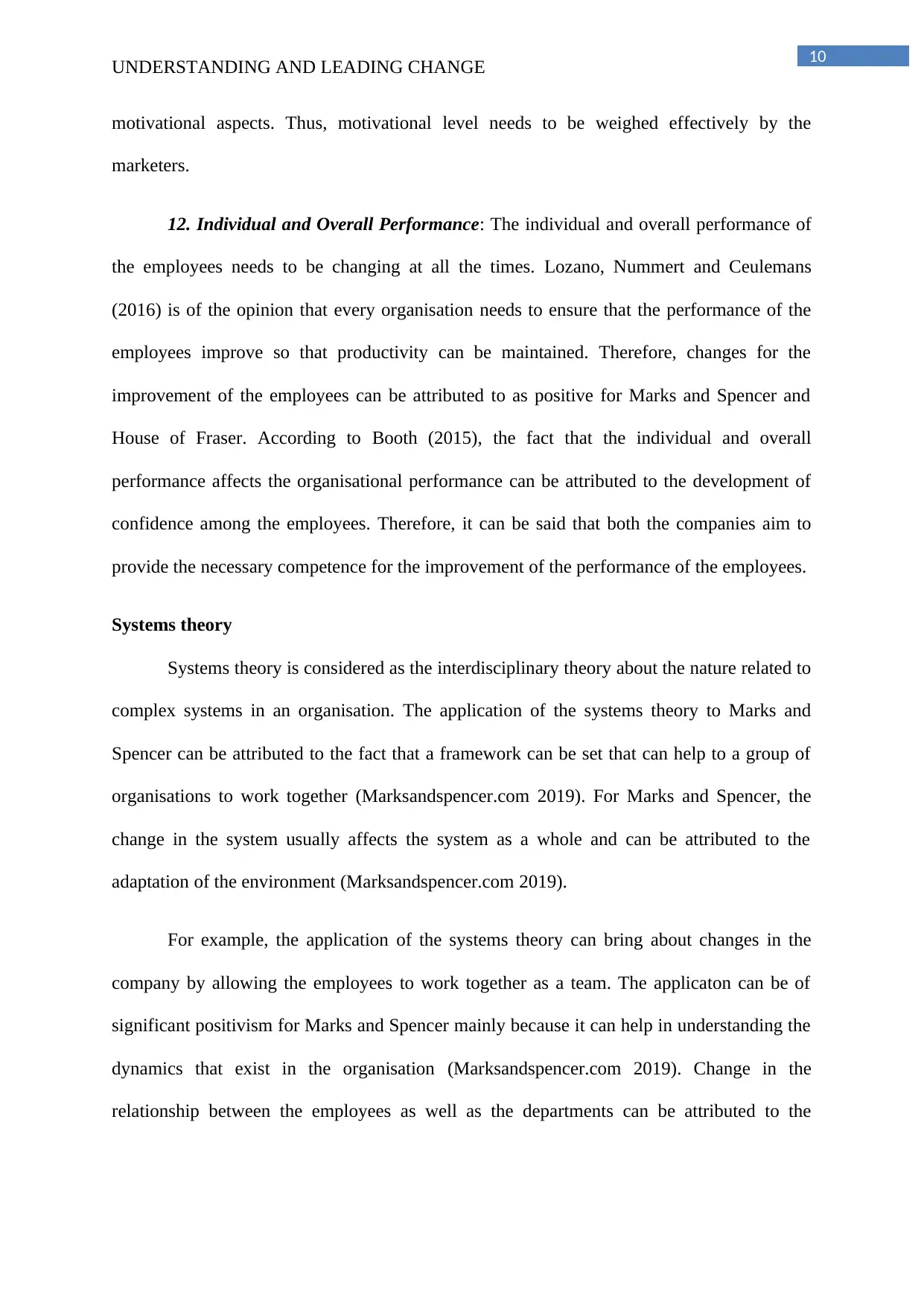
10
UNDERSTANDING AND LEADING CHANGE
motivational aspects. Thus, motivational level needs to be weighed effectively by the
marketers.
12. Individual and Overall Performance: The individual and overall performance of
the employees needs to be changing at all the times. Lozano, Nummert and Ceulemans
(2016) is of the opinion that every organisation needs to ensure that the performance of the
employees improve so that productivity can be maintained. Therefore, changes for the
improvement of the employees can be attributed to as positive for Marks and Spencer and
House of Fraser. According to Booth (2015), the fact that the individual and overall
performance affects the organisational performance can be attributed to the development of
confidence among the employees. Therefore, it can be said that both the companies aim to
provide the necessary competence for the improvement of the performance of the employees.
Systems theory
Systems theory is considered as the interdisciplinary theory about the nature related to
complex systems in an organisation. The application of the systems theory to Marks and
Spencer can be attributed to the fact that a framework can be set that can help to a group of
organisations to work together (Marksandspencer.com 2019). For Marks and Spencer, the
change in the system usually affects the system as a whole and can be attributed to the
adaptation of the environment (Marksandspencer.com 2019).
For example, the application of the systems theory can bring about changes in the
company by allowing the employees to work together as a team. The applicaton can be of
significant positivism for Marks and Spencer mainly because it can help in understanding the
dynamics that exist in the organisation (Marksandspencer.com 2019). Change in the
relationship between the employees as well as the departments can be attributed to the
UNDERSTANDING AND LEADING CHANGE
motivational aspects. Thus, motivational level needs to be weighed effectively by the
marketers.
12. Individual and Overall Performance: The individual and overall performance of
the employees needs to be changing at all the times. Lozano, Nummert and Ceulemans
(2016) is of the opinion that every organisation needs to ensure that the performance of the
employees improve so that productivity can be maintained. Therefore, changes for the
improvement of the employees can be attributed to as positive for Marks and Spencer and
House of Fraser. According to Booth (2015), the fact that the individual and overall
performance affects the organisational performance can be attributed to the development of
confidence among the employees. Therefore, it can be said that both the companies aim to
provide the necessary competence for the improvement of the performance of the employees.
Systems theory
Systems theory is considered as the interdisciplinary theory about the nature related to
complex systems in an organisation. The application of the systems theory to Marks and
Spencer can be attributed to the fact that a framework can be set that can help to a group of
organisations to work together (Marksandspencer.com 2019). For Marks and Spencer, the
change in the system usually affects the system as a whole and can be attributed to the
adaptation of the environment (Marksandspencer.com 2019).
For example, the application of the systems theory can bring about changes in the
company by allowing the employees to work together as a team. The applicaton can be of
significant positivism for Marks and Spencer mainly because it can help in understanding the
dynamics that exist in the organisation (Marksandspencer.com 2019). Change in the
relationship between the employees as well as the departments can be attributed to the
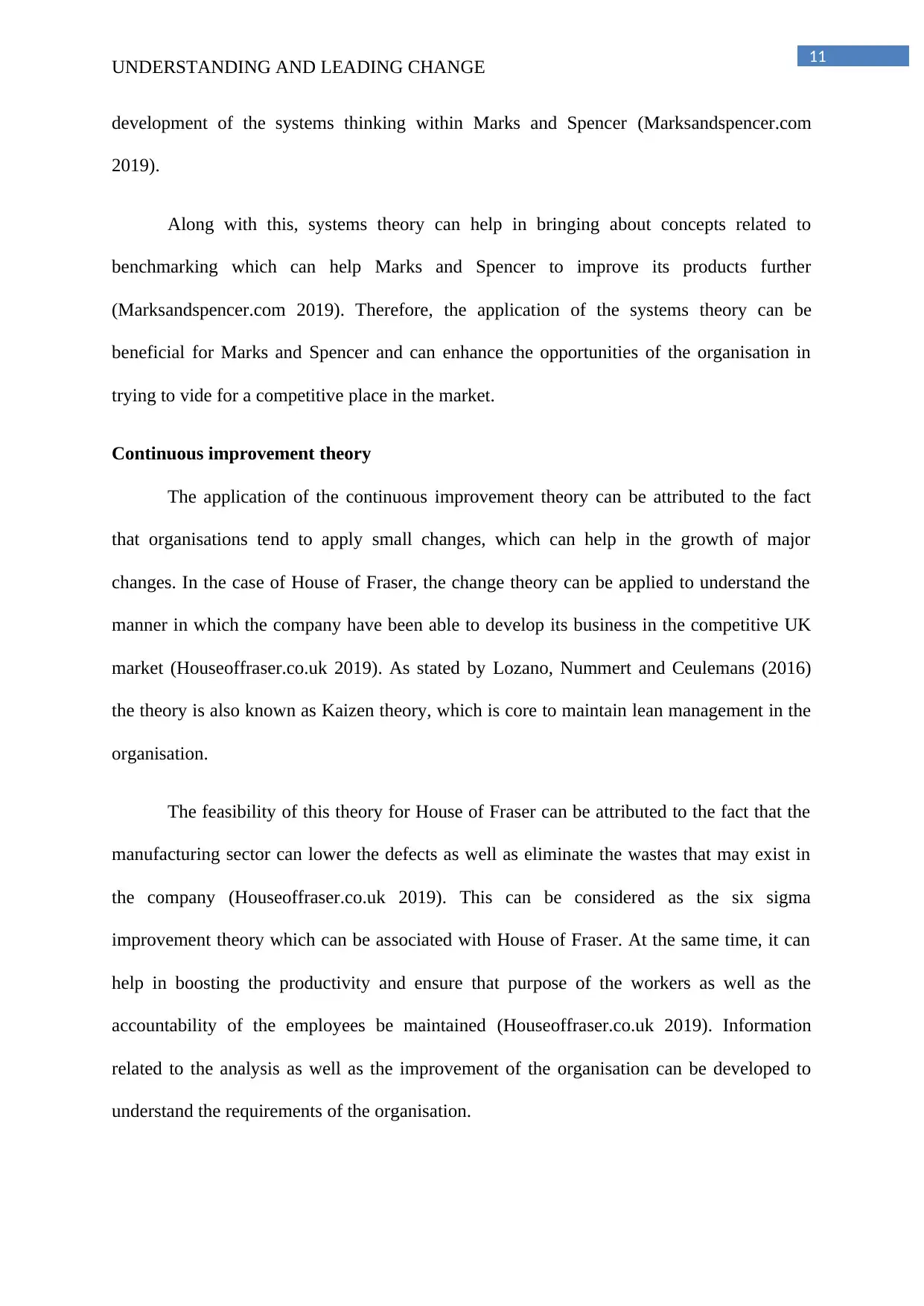
11
UNDERSTANDING AND LEADING CHANGE
development of the systems thinking within Marks and Spencer (Marksandspencer.com
2019).
Along with this, systems theory can help in bringing about concepts related to
benchmarking which can help Marks and Spencer to improve its products further
(Marksandspencer.com 2019). Therefore, the application of the systems theory can be
beneficial for Marks and Spencer and can enhance the opportunities of the organisation in
trying to vide for a competitive place in the market.
Continuous improvement theory
The application of the continuous improvement theory can be attributed to the fact
that organisations tend to apply small changes, which can help in the growth of major
changes. In the case of House of Fraser, the change theory can be applied to understand the
manner in which the company have been able to develop its business in the competitive UK
market (Houseoffraser.co.uk 2019). As stated by Lozano, Nummert and Ceulemans (2016)
the theory is also known as Kaizen theory, which is core to maintain lean management in the
organisation.
The feasibility of this theory for House of Fraser can be attributed to the fact that the
manufacturing sector can lower the defects as well as eliminate the wastes that may exist in
the company (Houseoffraser.co.uk 2019). This can be considered as the six sigma
improvement theory which can be associated with House of Fraser. At the same time, it can
help in boosting the productivity and ensure that purpose of the workers as well as the
accountability of the employees be maintained (Houseoffraser.co.uk 2019). Information
related to the analysis as well as the improvement of the organisation can be developed to
understand the requirements of the organisation.
UNDERSTANDING AND LEADING CHANGE
development of the systems thinking within Marks and Spencer (Marksandspencer.com
2019).
Along with this, systems theory can help in bringing about concepts related to
benchmarking which can help Marks and Spencer to improve its products further
(Marksandspencer.com 2019). Therefore, the application of the systems theory can be
beneficial for Marks and Spencer and can enhance the opportunities of the organisation in
trying to vide for a competitive place in the market.
Continuous improvement theory
The application of the continuous improvement theory can be attributed to the fact
that organisations tend to apply small changes, which can help in the growth of major
changes. In the case of House of Fraser, the change theory can be applied to understand the
manner in which the company have been able to develop its business in the competitive UK
market (Houseoffraser.co.uk 2019). As stated by Lozano, Nummert and Ceulemans (2016)
the theory is also known as Kaizen theory, which is core to maintain lean management in the
organisation.
The feasibility of this theory for House of Fraser can be attributed to the fact that the
manufacturing sector can lower the defects as well as eliminate the wastes that may exist in
the company (Houseoffraser.co.uk 2019). This can be considered as the six sigma
improvement theory which can be associated with House of Fraser. At the same time, it can
help in boosting the productivity and ensure that purpose of the workers as well as the
accountability of the employees be maintained (Houseoffraser.co.uk 2019). Information
related to the analysis as well as the improvement of the organisation can be developed to
understand the requirements of the organisation.
⊘ This is a preview!⊘
Do you want full access?
Subscribe today to unlock all pages.

Trusted by 1+ million students worldwide
1 out of 23
Related Documents
Your All-in-One AI-Powered Toolkit for Academic Success.
+13062052269
info@desklib.com
Available 24*7 on WhatsApp / Email
![[object Object]](/_next/static/media/star-bottom.7253800d.svg)
Unlock your academic potential
Copyright © 2020–2025 A2Z Services. All Rights Reserved. Developed and managed by ZUCOL.





